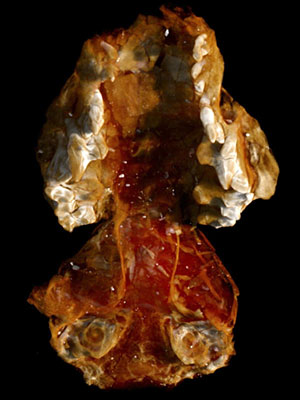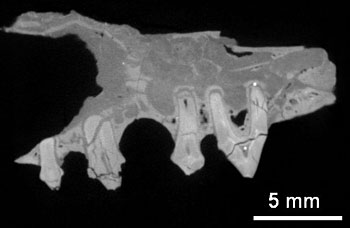LONDON, May 5, 2006 -- Scientists using a unique three-dimensional microscope that works in a new way said it is giving researchers unprecedented insight into microscopic internal structure and chemical composition. It is revealing how materials are affected, over time, by changes in temperature, humidity, weight load and other conditions. The device could help researchers gain a better understanding of diseases such as osteoporosis and lead to advances in construction materials, oil extraction methods and even fossil study. 
The new microscope in action: the x-ray generator is on the left, the specimen for examination is in the middle and the lead-lined camera is on the right. (Pictures and images: EPSRC)
Like a number of other microscopes, the new microscope harnesses x-rays to provide information about an object's internal structure down to the micron (millionths of a meter) scale. What makes it unique, researchers said, is its innovative use of a technique called "time delay integration," through which the camera incorporating the sensor is moved through the x-ray shadow while collecting the x-ray image. At the same time, the image being created on the surface of the sensor is electronically shifted in the opposite direction. In this way, any imperfections are "smoothed out" by averaging them over all pixels before the 3-D image is generated, which enables it to generate much better images of larger objects than any other device. This means that microscopic structures can be studied with greater accuracy. 
A computer-enhanced image of the jaw of viverravus acutus, a small, meat-eating mammal that lived approximately 50 million years ago, constructed from data produced by the new microscope.
With £154,000 (approximately $285,000) in funding from the Engineering and Physical Sciences Research Council (EPSRC), a UK government agency for funding research and training in engineering and the physical sciences, a multidisciplinary team drawn from six UK universities has been developing and using the microscope, which can view things in much greater detail than its relative, the CT scanner.
The three-and-a-half year research project involved experts in electronic engineering, physics, biophysics, chemistry, anatomy, materials science, dentistry, veterinary medicine and engineering from: Queen Mary, University of London; Cranfield University; Imperial College London; The Royal Veterinary College; The University of Manchester; and The University of Southampton. 
An image obtained by the new microscope of viverravus acutus.
X-ray microscopes can produce 3-D internal pictures of an object by taking a large number of 2-D images from different angles -- this is known as x-ray microtomography. However, the new microscope's combining of this technique with time delay integration is completely different, the researchers said. Through averaging out imperfections in the image across all pixels, this approach enables the microscope to produce clearer and bigger pictures than previously possible.
Professor Jim Elliott of Queen Mary, University of London, led the project. "As well as developing these microscopes to study subtle variations in internal structure, a main aim of ours is to work with the wider scientific community to identify problems where they could make a real contribution," he said. "There's no limit to what it would be useful or interesting to look at." 
An approximately 54 million-year-old viverravus acutus fossil on loan from the University of Michigan Museum of Paleontology, currently being studied by David Polly at Queen Mary, University of London.
The microscope looks like it will be a valuable research tool that many different organizations in a wide range of sectors could benefit from using, he said. The team is currently planning to seek funding to support the development of a radical new design that could be even more effective.
For more information, visit: www.epsrc.ac.uk